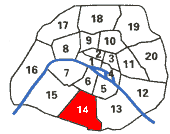|
At the end of the lobby, there are a rather nice café, a small arcade room, and some computers connected to the Internet, free but without keyboards and set on Gaumont's web site (they were removed later).
The largest auditoriums (1, 2, 3 and 8) are equipped with Dolby SRD and SDDS (there is no DTS); all the other auditoriums are equipped with Sony Cinema Stereo sound (equivalent to Dolby SR). Since the opening, theaters 4, 11 and 12 also got Dolby SRD. All the screens are curved, and there is stadium-style seating in every auditorium. The auditoriums are all black and red.

Above, the plan of theaters 1-7
An escalator leads to theaters 1-4.

On the second level, theater 1 replaces the former theater 1. Il has stadium-style seating, a 40ft wall-to-wall curved screen and 383 seats. It is now shorter than old theater 1. The auditorium burned down shortly after the opening, and it had to be redone.

Behind theater 1, the new theater 2 replaces the old theater 5, the lobby, and the back part of the old theater 1. It has 282 seats and a 36ft screen. By its shapes and colors, the ceiling is very original.
On the third level, theater 3 replaces old theater 2, the appartment and the garden (the building is now higher than it was). It is wider than long, and its 177 seats and 40ft screen make it more pleasant than theater 2.
Theater 4 is located next to theater 3. It is a small 117-seat auditorium with a 22ft screen. Like the other small auditoriums in the cinema, it looks like other small Gaumont theaters (Gaumont Italie 2-3, Gaumont Opéra Premier 5-6). Viewing conditions are correct, but the screen could be larger.
In the basement, theaters 5, 6 and 7 replace the old theaters 3 and 4. Theaters 5 and 6 are identical (88 seats, 25ft screens), and theater 7 isn't very different (87 seats, 26ft screen). I still can't understand how two medium size auditoriums (700 seats total) could have been replaced by three small auditoriums, even with larger distances between the seat rows; the bar may have taken some of the volume (see the plan). It is not possible to see the projection booth anymore, but viewers about to enter the auditoriums might spot the projectionist walking on a small bridge over their heads on his way to the new projection booth.

It is now time to enter the other half of the complex, after a walk throught a starlit tunnel, which reminds of the escalators at the Pathé Belle-Epine, in the suburbs. This part of the multiplex is much quieter. The retro-style bar (left) is beautiful.
Theater 8 (384 seats, 40ft screen) barely is the largest in the cinema. It replaces theater 1 of the old Gaumont Parnasse, but stadium-style seating was added.
Theater 9 replaces the old theater 2; it has less seats, a similar screen and stadium-style seating, and of course viewing conditions are improved (81 seats, 22ft screen).
Theaters 10 and 11 (105 and 163) have identical screens (24ft wide). They replace the old theaters 4 and 5, and parts of the main corridor.

In the basement, theater 12 replaces the old theater 3. It looks as nice as the other, it has 129 seats, but its 18ft screen is the smallest in the complex, and should be larger.
The projection booth

The cinema has a complex network of projection booths. A first main booth serves theaters 1 and 2; theaters 3 and 4 each have their own booths (the projectionist needs to walk through the auditoriums to reach the booths). In the basement, the projectors are equipped with endless loops systems (they don't need to be reloaded between shows).
The second projection booth can be seen from the lobby; it serves theaters 9, 10 and 11. Theaters 8 and 12 have their own booths.
Two projectionists are working simultaneously. In the main booths, a synthetic voice announces on the computers every step of the shows (including lights, sounds levels, which are lower during the commercials, format changes).
Most of the movies are dubbed in French, but some are played in their own languages (among them was Titanic).
This multiplex doesn't offer any really large screens ("the walls couldn't be pushed back") and its numerous small auditoriums, but it is often crowded. In 1998, its attendance made it the second cinema in Paris (behind the UGC Ciné Cité les Halles), and the sixth in France, with 1.5 million tickets sold. In 1999, no more Titanic, the Gaumont Parnasse sold 1,3 million tickets, ranking third in Paris (behind the UGC Ciné Cité les Halles and Bercy) and eighth in France.
| 











































